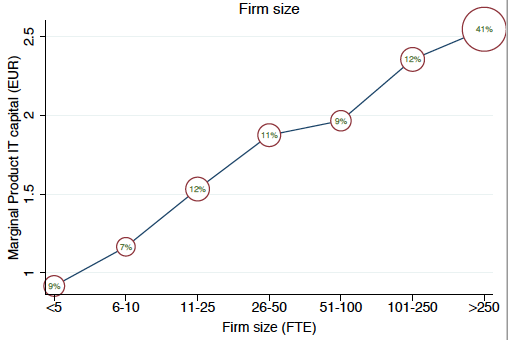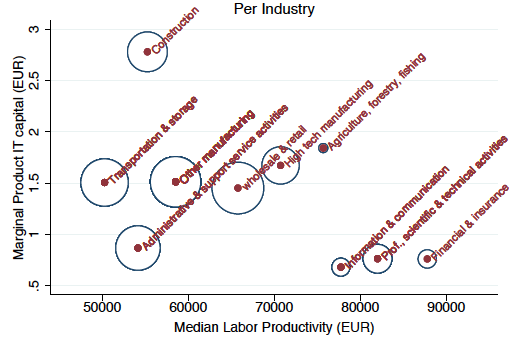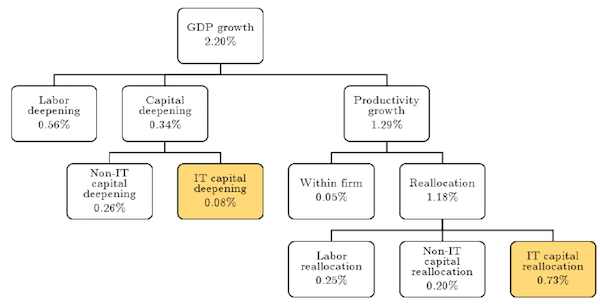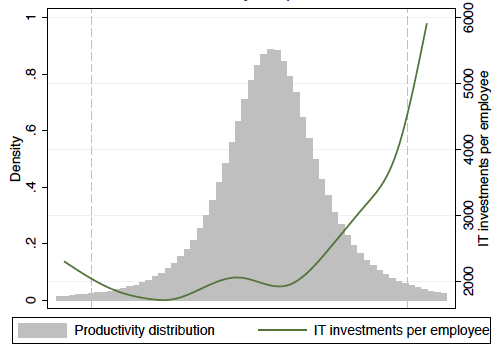By Emmanuel Dhyne, Senior Economist, National Bank of Belgium, Jozef Konings, University of Liverpool Management School, University of Leuven and CEPR Research Fellow, Jeroen Van den bosch, PhD Candidate in Economics, University of Leuven, and Stijn Vanormelingen, Assistant Professor of Economics, KU Leuven. Originally published at VoxEU.
Although information technology has reshaped the way businesses operate, measuring IT capital in firms is challenging. Using an exceptionally rich firm-level dataset from Belgium, this column finds that large firms benefit more from IT than small firms, and that IT explains about 10% of the productivity dispersion. IT has contributed to Belgian GDP and productivity growth prior to the Global Crisis, but the recession seems to have led to firms to forego investment in IT. Achieving optimal IT investment levels could reinvigorate productivity growth.
The interest from economists and politicians in information technology (IT) is not new. However, opinions among economists about the importance of IT are divided. While Robert J. Gordon, macroeconomist and economic historian at Northwestern University, has been arguing against techno-optimism for a long time, MIT professors Erik Brynjolfsson and Andrew McAfee suggest in their recent book, The second machine age, that most of the productivity gains from IT are still to come. In our recent study (Dhyne et al. 2018), we provide new insights on the returns of IT by constructing firm-level IT capital stocks from an exceptionally rich data set of all Belgian business-to-business transaction data on IT purchases. This allows us to investigate which firms benefit most from IT. Furthermore, our work provides insights into the ‘Solow paradox’, which refers to the fact that we do not see much effect of IT on macroeconomic GDP growth. Since we use the universe of Belgian firms, we are able to show the micro channels of the aggregate impact of IT on macroeconomic productivity growth.
Large Firms Benefit More from IT
Do all firms benefit equally from IT, or do some benefit more than others? We show that for very small firms with fewer than five full-time employees, an increase of IT capital by 1% pushes the firm’s value added up by 0.08% on average. For firms with more than 250 employees, the impact is more than twice as high with an average increase in value added of 0.17%. We would therefore expect that large firms invest a larger share of their revenues in IT than small firms. However, it turns out that they do not, and consequently their return on IT is higher. Figure 1 shows the differences in the return of investing one additional euro in IT (the gross marginal product of IT capital) across the firm size distribution. Increasing the IT capital stock by €1 in very small firms with fewer than five full-time employees results in a €0.92 increase in value added. The same investment in firms with more than 250 employees has a €2.55 return.1 This suggests that there is an untapped potential for productivity growth by investing in IT, especially for large firms. As large firms employ about 40% of the working population, higher IT investments in large firms would also boost economy-wide productivity growth.
Figure 1 The relation between the marginal product of IT capital and firm size (size of circles indicates share of the working population)

The Return on IT Depends on the Activity of the Firm
Another piece of the puzzle on the economy-wide impact of IT is understanding how the return varies across industries. Figure 2 displays the gross return of investing an additional euro in IT. The horizontal axis ranks the industries according to their productivity, expressed in value added per employee.
Figure 2 The marginal product of IT capital across industries (size of circles indicates share of the working population)

The productivity of firms in industries with a high marginal product of IT capital increases when they invest more in IT. Graphically, this results in moving towards the lower right corner of Figure 2. Only a few industries are located in this region – such as information and communication, and financial and insurance – which are amongst the most IT-intensive industries. As indicated by the size of the circles, the largest part of the working population can be found in industries with lower productivity levels. Fortunately, in many of these industries with relatively low productivity, the marginal product of IT capital is relatively high. For example, the transportation and storage, manufacturing and wholesale, and retail industries all realise about €1.5 added value for €1 of extra investment in IT, while altogether these industries employ 35% of the working population. The positive relation between IT intensity and productivity suggests that these industries would realise substantial productivity gains by investing in IT.
Underinvestment and Misallocation of Investments Explain (Part of) the Productivity Paradox
Next, we decompose GDP growth into primary input growth (capital and labour deepening) and productivity growth to assess the importance of IT capital at the macro level.
First, we look at the contribution of capital and labour deepening to GDP growth. Figure 3 shows all the mechanisms at work, and their individual contribution to Belgian GDP growth over the period 2002-2013. While the Belgian economy grew (on average) 2.2% per year between 2002 and 2013, the contribution of IT capital deepening was only 0.08%. This is especially driven by a decline in IT investments during and after the Great Recession of 2008-2009. Before the recession, the contribution of IT capital deepening was on average 0.19%, but afterwards, in 2010-2013, there was no contribution to GDP growth from IT capital deepening. This suggests that the Great Recession resulted in firms foregoing investments in IT. This post-recession underinvestment in IT explains the low overall contribution of IT capital deepening to GDP growth.
Figure 3 Decomposition of GDP growth in the private sector in Belgium for the period 2002-2013

Second, we look at the contribution of productivity growth to aggregate GDP growth. While productivity growth was only 1.29% (on average) between 2002 and 2013, it accounted for the largest part of GDP growth. Despite the post-2000 decline in productivity growth (Van Ark 2014), firms generally increased their IT investment intensity. As shown in this study and earlier firm-level studies, IT investments provide large returns to firms. So how can these two findings be reconciled? To understand how IT relates to productivity growth at the country level, we distinguish between: (i) within growth, which occurs when all firms become more efficient, and (ii) reallocation when there are more (fewer) investments in firms where the potential return on investments is high (low). IT reallocation contributed, on average, 0.73% to Belgian productivity growth. So, the mechanism by which those firms with high returns on IT actually invested in IT accounted for more than half of total productivity growth. What is particularly striking is that this number is entirely driven by the pre-recession period. For the years 2010-2013, the average contribution of IT capital reallocation to the productivity growth fell back to a mere 0.09%. This indicates that IT did contribute to Belgian productivity growth. However, this was particularly the case before the recession, while afterwards firms that should have invested in IT did not do so. This suboptimal allocation of investments is one part of the puzzle of the slowdown in productivity growth after the Great Recession.
IT Explains 10% of the Productivity Dispersion across Firms
Not all firms are equally productive. Even among firms that produce very similar products, there are large differences in production efficiency. The dashed vertical lines of Figure 4 show the 10th and 90th percentiles of the productivity distribution,2 and the green line shows the average IT investments per employee. A firm in the 90th percentile of the productivity distribution is about four times as productive as a firm in the 10th percentile of the productivity distribution, while average IT investments per employee are about five times as high for a firm in the 90th percentile compared to a firm in the 10th percentile of the productivity distribution. For the US, the earlier literature found that IT explains 8% of dispersion in productivity across firms. For Belgium, about 10% of the productivity dispersion between firms can be explained by IT.
Figure 4 Productivity dispersion and IT intensity

Concluding Remarks
The key takeaway is that IT and the productivity of firms are very closely related. While all firms benefit from IT, it is the largest firms that benefit most. Furthermore, the gross marginal product of IT capital is relatively high, with €1.5 added value for €1 of extra investment in the majority of relatively low-productivity industries. When reconciling firm- and industry-level returns of IT investments with the growth of the Belgian economy, we find that IT did contribute to national GDP and productivity growth. However, this was only so until the Great Recession of 2008-2009. The recession seems to have had a scarring effect and resulted in firms foregoing investing in IT. The policy implication is that providing an economic environment which facilitates achieving optimal IT investment levels could help to invigorate productivity growth.


Maybe I’m missing something here, but the way I interpret this is because firms whose product / value is 100% IT get higher productivity by spending more on IT, firms whose product / value is less dependent on IT because they have labor and materials costs, would benefit from spending more on IT.
Of course, the negative consequences aren’t really showing up in this analysis, (the scarring effect?) particularly as the economy pointed to in the summary is the Belgian economy. That, considering its being the heart of the EU, would seem to be, if I may insert a fanciful analogy, a unicorn in the midst of a herd of zebras.
I was amused by how this article completely ignored the biggest beneficiary of IT – SCIENCE. We elder folks recall the amazing boost to the pace of discovery by ARPANET, then BITNET, even before there was an INTERNET. We could share data in analyzable form very fast for the times. Often emails were more productive than phone chats because we had time to think before commenting, and even crunch some numbers before chatting.
Back in 2012, I found myself invited to EU HQ in Brussels to try to explain why a comprehensive (and costly) database such as we had at NIH would help justify budget increases for the European Research Council. They were still very much paper-dependent at the time.
Of course, IT also has enabled improved epidemiology research because it is now cost-effective to track 10s of thousands of people over decades. It also facilitates cost-benefit analyses too. Of course, the old dilemma of crap-in/crapout still muddles conclusions.
I guess my complaint lies mainly in how this article overlooks how scientific discovery promotes progress in all industries – or am I being to myopic?
No, you’re not being myopic. Scientific discovery leads to technological advancement which leads (potentially) to more detailed discovery (and better scientific theory).
An example is clear with Arpanet. It began as a way for scientists (doing military work) at several universities to better share their work. However, they needed a way for those communications to be secure so each campus computer needed to be specifically identifiable. Worked great at small scale.
Upscaled, the Arpanet led to the Internet (World Wide Web) which still requires specifically identifiable machines to accurately route traffic (communications). At the large scale (worldwide) your computer (smartphones are small computers) and YOU are now readily identifiable and track-able.
In the past the number of items (people) in a relational database was a computational problem. When science/technology developed cheap mass memory devices, that limitation went out-the -window. (And now requires massive amounts of cheap electricity for NSA Server complexes in Utah.)
So I am a long-time senior manager in IT. And this article is just stating the obvious. The critical factor for getting productivity gains from IT investments is having people whose job it is to do so. So larger firms have the funding to hire capable IT staff. Smaller firms do not. So larger firms get a better ROI even with having the additional overhead of the IT staff. And those firms that rely heavily on accurate information systems for their lifeblood have already made the significant investments needed. Further investments have a much diminishing ROI.
my wife used to work for a very small contractor in NY, that had a very small work force, but the company wasnt really into automation, and had not IT person at all for them IT was just tools to have to do things like taxes. but it didnt get used to manage the business. doubt that isnt unusual eithe
In recent times, I am having more and more doubts on the returns on Information Technology as more and more of it is just a dumpster for money that might be used elsewhere to help the profitability of a company. Having just written that, I wonder if a reason why companies fire workers or reduce their benefits is to be able to shovel more to IT. Let’s try this on for size.
Does anybody really believe that IT has benefited voting in the US? In the past there was hand counted paper votes that left an auditable trail and it was a simple system. Now you have computer voting. The technology is getting old on these machines and they need replacing – again and again. They break down. They cast the wrong vote, They are easily hackable. Lots them leave no trail who voted or how many when turned off. Even back in 2000, tens of thousands of votes on these IT systems would disappear and reappear on the count for another political party.
So with this in mind, was this adoption of IT a benefit to voting or a net loss. A benefit to an army of IT consultants and techies that had to be hired to run all this crap but for American democracy it has been a major loss in my opinion. And that is just one field. I am sure that there are many stories people have heard of with projects where the IT costs blew out and made life hell for the people that had to use it. Just this week the hospital system in my State have announced a cost blowout of about $250 million in an IT project and that it is not providing value for money. The author suggest that big companies should throw yet more money in the IT dumpster but I really have my doubts of any solid returns on any money spent.
This is interesting and it is stating the obvious. IT spending should lead to higher productivity and it is nice to see that there is data to prove it. This does not preclude waste and wasted projects which routinely happen in the industry. On the other hand, IT investment is actually that, investment, and companies that don’t invest in their business are eventually cast aside. As an example, see ESL at Sears. They invested nothing in the business for years because they wanted to maintain margins while Amazon invested heavily and did not worry too much about margins. Same I think is happening with Apple now. They are obsessed with margins but not so much with investment. They seem to have lost India and are now close to completely losing China. I had some anecdotal evidence from India where some of my well to do colleagues dumped Apple products 2 years ago because they got too “high end” in price without the necessary “high end” customer service. I think we know where this is going if Apple does not invest in new products and customers and stops investing in buy-backs.
Being involved in a largish construction project which is very much relying on IT services and 3D modelling, I would tend to be sceptical of productivity improvements in construction based on “better/more” IT.
What has happened in “my project” is that enormous amounts of effort and resources goes into license management, system development, system integration, data collection and data quality work. Then the builders try to recover those costs … Investments (hehe) … by doing “3D integration” where they squeeze the dimensions of every building and “optimise”, for example by designing away generic raised floors in favour of fixed “slots” for electrical switchgear.
Of Course several things happen: The dimensions of the equipment changes, rather than lifting a few more floor tiles, we are now into cutting concrete. The data was incorrect after all so now major equipment is not were it was supposed to be which would not normally be a problem except they squeezed …. Optimised … the size of the buildings hosing the equipment so now everything collides and the plant layout has to be reworked.
Somehow they managed to let subcontractors own the models so every time one needs to do re-work on a CAD model, it is a license to extort by the subcontractors.
Colourful CAD drawings with 5-digit dimensions in mm tends to be trusted far too much by contractors and nobody “downstream” of this huge, shining, Temple-of-3D_CAD actually thinks and checks with reality. I mean, every little thing has got like 29 digital signatures on the release forms so surely it was checked!? (Bwahahhaa!)
All in All, I would bet be a “Glenmorangie Nadurrah” that if we had used “Under-arm-length” as the base unit for construction and simply measured with knotted strings – like the Romans did – we would only have spent some percentage of the license and consultancy costs wasted on IT-tools on more square meters than needed and overall the project would have been cheaper and in a better shape.
Done “the analogue way”, there would be mistrust in the design, the achievable precision is for construction and margins would therefore be set appropriately, thus when something is out by one under-arm-length we could just move it because someone figured that would happen!
PS –
I think the whole mess is because we are so good at producing things efficiently, there is no good use for maybe 80% of the population on the production side, but, we have to “gainfully employ” those people anyway or all manner of badness happens. To solve this, we bloat the systems- and process- aspects of the available work to create slots for these people and IT just happens to be the perfect tool for creating unlimited complexity and bloat without impacting the core pipeline too much.
In other words, Digitalisation is in many applications a tax on efficiency. The revenue is distributed to people working as consultants, usually academics!
I’ve heard very mixed reports from people I know at the coalface on construction projects (I used to work in that sector, now I just hear things second hand). There is no doubt that some types of construction have benefited – I’ve seen some commercial buildings erected at astonishing speeds through better integration of design, construction, and in particular, the supply of pre-fabricated components. But as so often, I would agree that many of the benefits are double edged.
I once talked to a Union official in the public sector and asked him whether they opposed new technology for civil service and other government agencies. She said ‘hell no, in our experience it always results in an increase in staff!’ And she wasn’t joking.
However, having said that, my own job has become vastly easier because of government IT improvements – I can now get an enormous amount of information in minutes from accessible databases, that even just 10 years ago would have required many days of research, library visits, letters and phone calls to gather together. This is a huge benefit for people working both within, and outside the government system. However, its also a huge subsidy to the private sector as a lot of consultants charge clients for information which they’ve gleaned in minutes from government research. I’ve no objection to this – its right and proper that government data is available free, but the people who take advantage are often the first to complain about their taxes.
@fajensen
An excellent point about the unintended consequences of too much “efficiency” — one of which is insufficient slack available for unforeseen errors leading to workarounds more expensive than a less “efficient” design which is more readily adaptable onsite.
Also, your last point is supported in some sense by Graeber’s “BS Jobs” thesis
Insufficient slack is a huge problem leading to a race to the bottom. Local minima far from the global minimum on a dynamic manifold. Thus the trains go to shit.